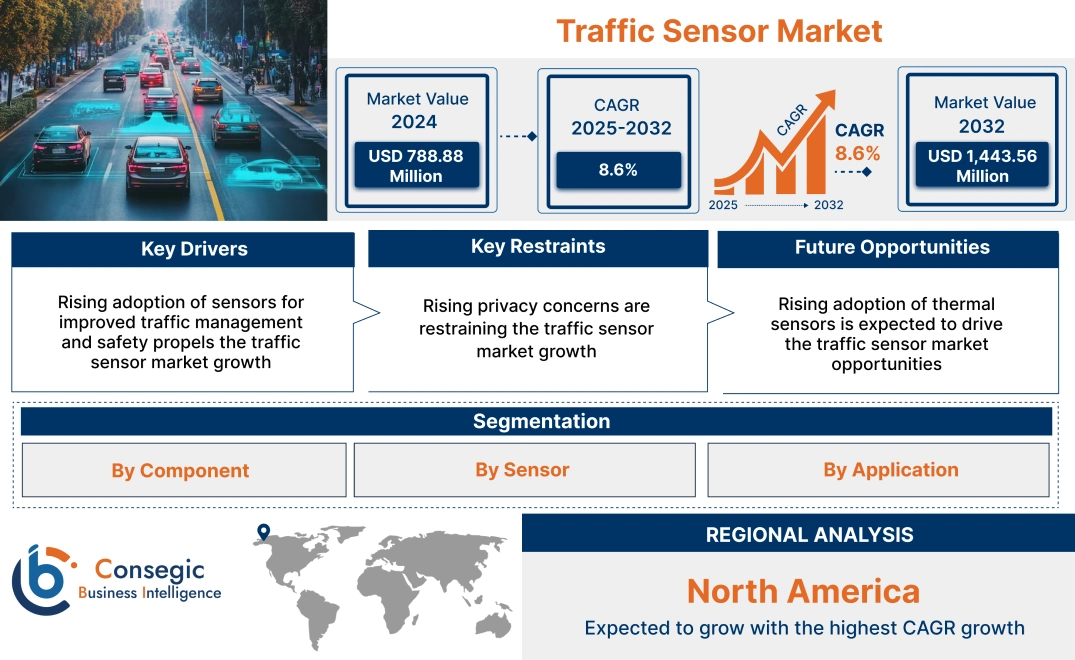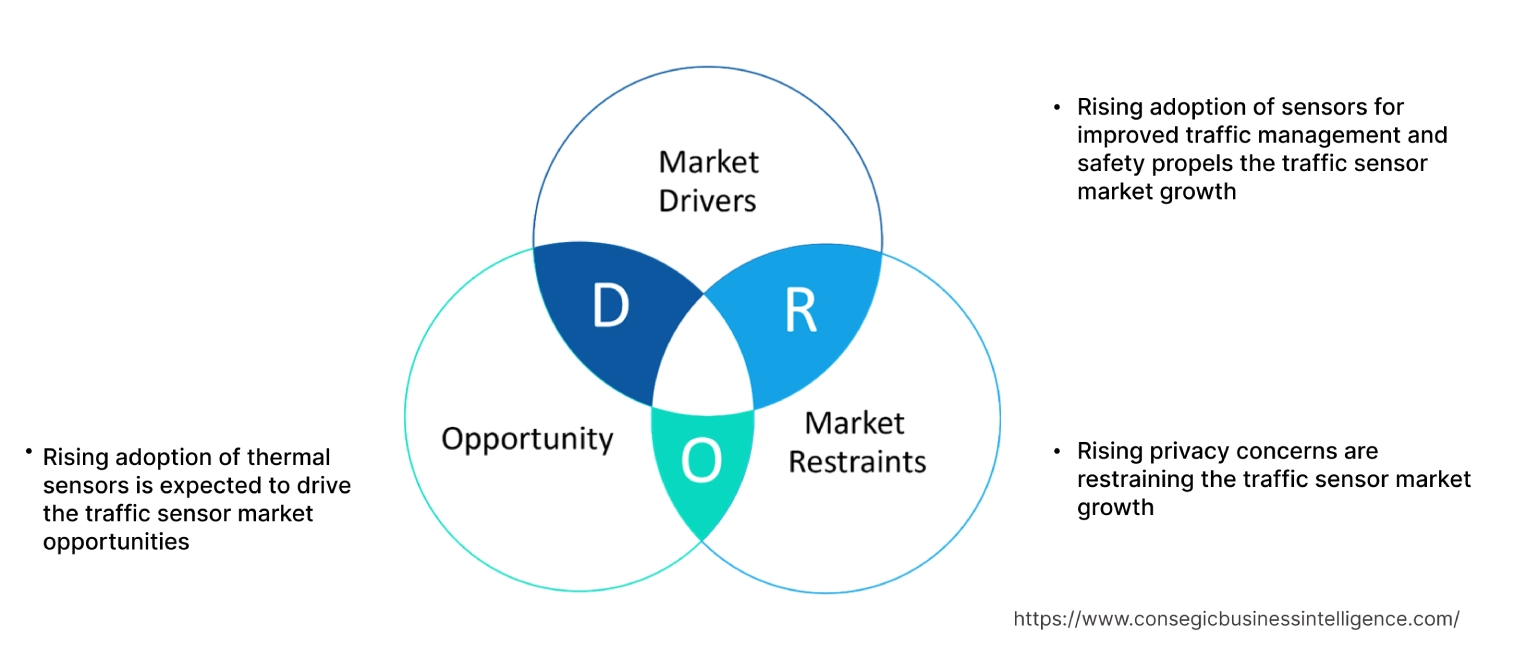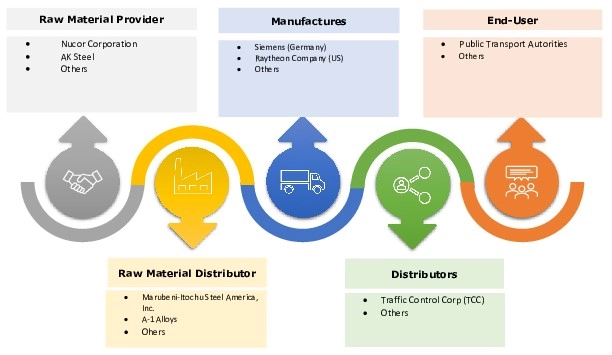- Summary
- Table Of Content
- Methodology
Traffic Sensor Market Size:
Traffic Sensor Market size is estimated to reach over USD 1,443.56 Million by 2032 from a value of USD 788.88 Million in 2024 and is projected to grow by USD 837.05 Million in 2025, growing at a CAGR of 8.6% from 2025 to 2032.
Traffic Sensor Market Scope & Overview:
Traffic sensor (TS) is used in traffic management systems to collect road traffic information for managing signal control and accumulated data through scanning images from traffic sensors, which are further supplied to vehicle information and communication system centers. Moreover, sensors are used for detecting traffic patterns, predicting mobility data, and automating actions by specifying conditions. Additionally, the sensor is integrated into intelligent transportation systems for different applications such as vehicle monitoring, traffic monitoring, drive support, and pedestrian monitoring.
Key Drivers:
Rising adoption of sensors for improved traffic management and safety propels the traffic sensor market growth
Increasing utilization of sensor technology is growing for improving traffic and the safety of passengers and pedestrians. The adoption of ITS (Implementing Traffic Systems) is increasing to reduce travel time and improve road usage. Further, the use of TS enables potential threats to be detected and it also provides warnings to drivers and pedestrians for preventing accidents. Additionally, by providing periodic data on road maintenance and construction and syncing with traffic signals, the overall traffic can be reduced by suggesting alternate routes to the commuters.
- For instance, in July 2024, WSP launched a traffic sensor system with real-time monitoring, safe traffic counting, and improved accuracy in New Zealand.
Thus, the rising advancements in sensor technology for traffic management and safety are driving the traffic sensor market size.
Key Restraints :
Rising privacy concerns are restraining the traffic sensor market growth
Increasing utilization of image sensors such as camera modules, digital cameras, optical mouse devices, and camera phones for detecting and collecting information in the form of images has raised privacy concerns. Traffic management systems continuously record and monitor the movement of pedestrians and automobiles, leading to the potential exploitation of personal information. Further, ensuring regular security of the database is critical while using systems such as traffic management and intelligent traffic systems for transportation.
Future Opportunities :
Rising adoption of thermal sensors is expected to drive the traffic sensor market opportunities
The utilization of thermal sensors in traffic management is rising due to their ability to classify objects without making any physical contact. Thermal sensor refers to the measurement of physical parameters through sensing temperature or heat. Further, the thermal sensor uses thermal energy emitted from automobiles for monitoring purposes. Additionally, thermal TS helps in detecting bikes and vehicles in dark and difficult weather environments for preventing accidents, collisions, monitoring, detecting, and others.
- For instance, in July 2024, Hanwha Vision launched TNM-C4940TDR/C4942TDR with advanced VGA thermal and 4K video for delivering clear images in different light conditions.
Thus, as per the traffic sensor market analysis, advancements in thermal sensing technology for clear images are driving the global traffic sensor market opportunities.
Traffic Sensor Market Segmental Analysis :
By Component:
Based on components, the market is segmented into software and hardware.
Trends in the Component:
- There is an increasing trend towards the adoption of hardware sensors for controlling traffic, avoiding accidents, and navigation.
- Rising utilization of advanced software with sensors due to its enhanced capability of traffic detection.
Hardware accounted for the largest revenue share of the total traffic sensor market share in 2024.
- Hardware components include infrared sensors, radar sensors, thermal sensors, inductive loops, piezoelectric sensors, and others, which are used for detecting and predicting traffic.
- Hardware components measure the physical behavior of traffic using different sensors by emitting invisible beams for detecting the presence of vehicles.
- Further, hardware sensor helps in real-time monitoring and efficient traffic management processes.
- For instance, in August 2022, Traffic Technology launched Zelt Evo sensor technology with improved detection of vehicles such as bikes and scooters.
- According to the analysis, the rising developments related to hardware technology including sensors and cameras are driving the traffic sensor market size.
Software is anticipated to register the fastest CAGR during the forecast period.
- Sensors and software are integrated to generate real-time traffic data for managing traffic in crowded environments.
- Further, software implementation enables split-second decisions in traffic management to reduce a significant amount of angle collisions at an intersection.
- Additionally, the integration of AI in traffic management software helps in route suggestions and reduces the travel time of passengers.
- For instance, according to the NIC Goa, in March 2023, the Chief Minister of Goa launched ITMs (Intelligent Traffic Management System) for monitoring traffic violations.
- According to the analysis, the rising developments related to software management systems for monitoring traffic are driving the traffic sensor market.
By Sensor:
Based on sensors, the market is segmented into image sensors, infrared sensors, radar sensors, thermal sensors, inductive loops, piezoelectric sensors, and others.
Trends in the Sensor:
- There is an increasing trend towards the adoption of thermal sensors for recognizing physical parameters based on collected temperature data.
- The adoption of piezoelectric sensors in traffic management systems is rising due to their ability to measure changes in strain, pressure, temperature, acceleration, and others.
Image sensors accounted for the largest revenue share of the overall total traffic sensor market share in 2024 and are anticipated to register the fastest CAGR during the forecast period.
- Image sensor captures light and converts the collected light into an electric signal, which is then processed to create a digital image.
- Moreover, there is a rising utilization of image sensors such as camera modules, digital cameras, and others for detecting information in the form of images.
- Further, high-quality images with low noise are collected using traffic image sensors for different scenarios such as the verification of number plates.
- For instance, in October 2023, Hikvision unveiled its multilane ANPR cameras and radar-assisted ANPR cameras integrated with image sensors for improving transportation security systems.
- Therefore, the rising advancements in image sensors for traffic management are driving the traffic sensor market trends.
By Application:
Based on the application, the market is segmented into traffic management, tolling, vehicle measure & profiling, and others.
Trends in the Application:
- There is an increasing trend towards the adoption of traffic management solutions for reducing carbon emissions.
- Rising utilization of vehicle measurement & profiling for determining average fuel consumption, average emissions, passenger occupancy, and others.
Traffic management accounted for the largest revenue share of 38.42% of the total share in 2024.
- Traffic management is a planned combination of measures that are implemented to improve the safety and security of the road transport system.
- Further, sensors such as image sensors, infrared sensors, thermal sensors, and others are used according to the traffic management solution.
- Traffic management software is used for controlling the light on the roads, collecting traffic density, navigation, and others.
- For instance, in October 2024, Seyond launched SIMPL (Seyond Intersection Management Platform) with advanced LiDAR technology and artificial intelligence to dynamically optimize traffic signal controls.
- According to the analysis, the rising advancements in traffic management systems are driving the traffic sensor market trends.
Tolling is anticipated to register the fastest CAGR during the forecast period.
- Tolling refers to the process of collecting fees from vehicles roads, bridges, and tunnels.
- Further, tolling involves the use of advanced sensors and technologies for the detection, and monitoring of traffic, vehicle measurement, and others.
- Additionally, the sensor is used to detect the vehicle information for calculating the toll based on the distance.
- For instance, in October 2023, Hikvision India launched a Multilane Free Flow Tolling Solution at the TrafficInfraTech Expo to improve the tolling system.
- According to the analysis, the rising advancements in tolling systems for efficiently collecting tolls are driving the traffic sensor market.
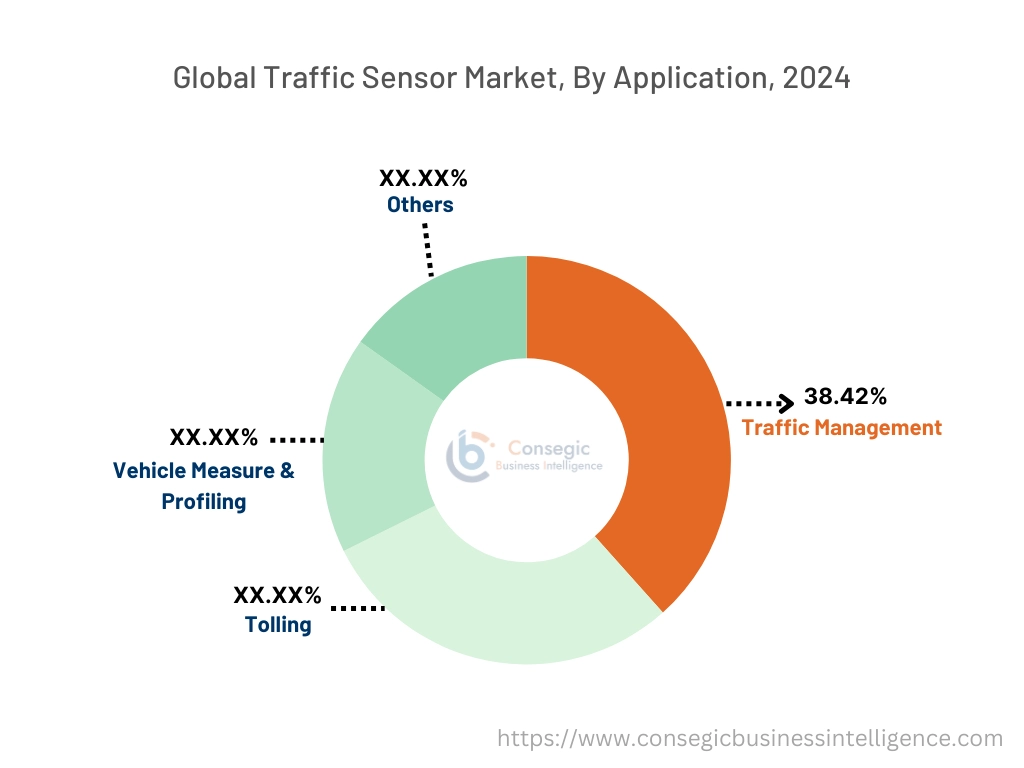
Regional Analysis:
The regions covered are North America, Europe, Asia Pacific, the Middle East and Africa, and Latin America.
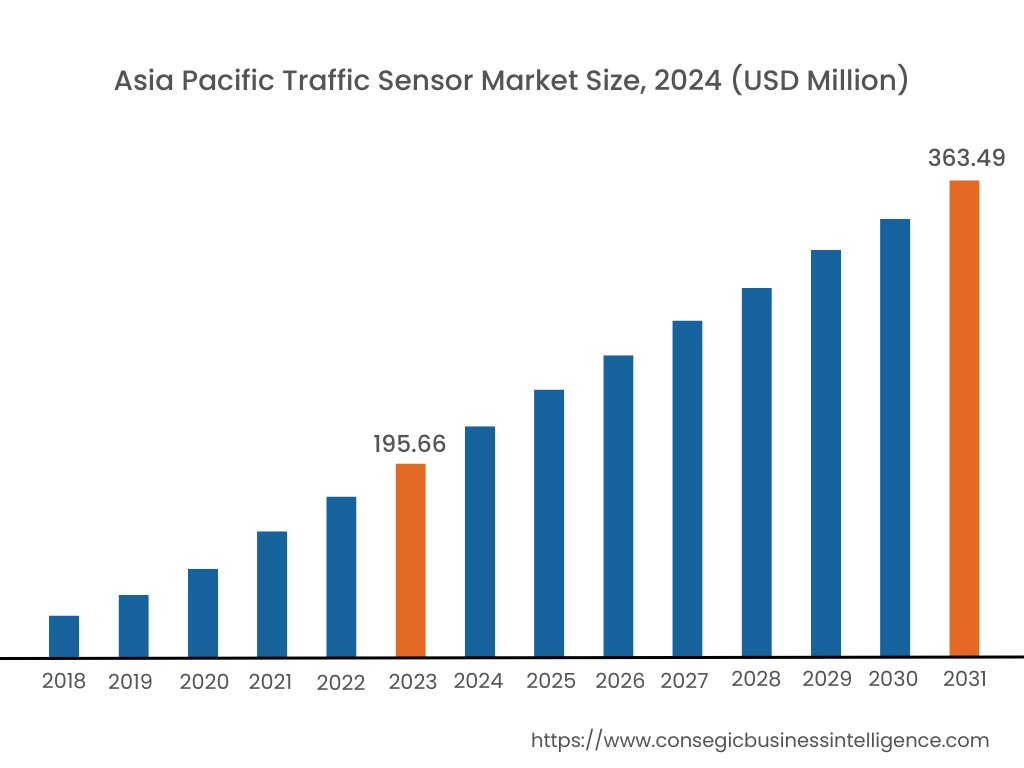
Asia Pacific region was valued at USD 195.66 Million in 2024. Moreover, it is projected to grow by USD 207.87 Million in 2025 and reach over USD 363.49 Million by 2032. Out of this, China accounted for the maximum revenue share of 30.0%. As per the traffic sensor market analysis, there is an increasing adoption of sensors, particularly in countries such as China, India, and Japan, for improving traffic management in congested developing nations. The rapid development and growing investments in megacities for increasing population are accelerating the traffic sensor market expansion.
- For instance, according to the International Organization of Motor Vehicle Manufacturers, the total sales of passenger cars in China reached 26,062,824 units in 2023, depicting an increase of 10.6% as compared to 23,563,287 units in 2022. This is further projected to drive the adoption of sensors for efficient traffic management, thereby, propelling the market in the Asia-Pacific region during the forecast period.
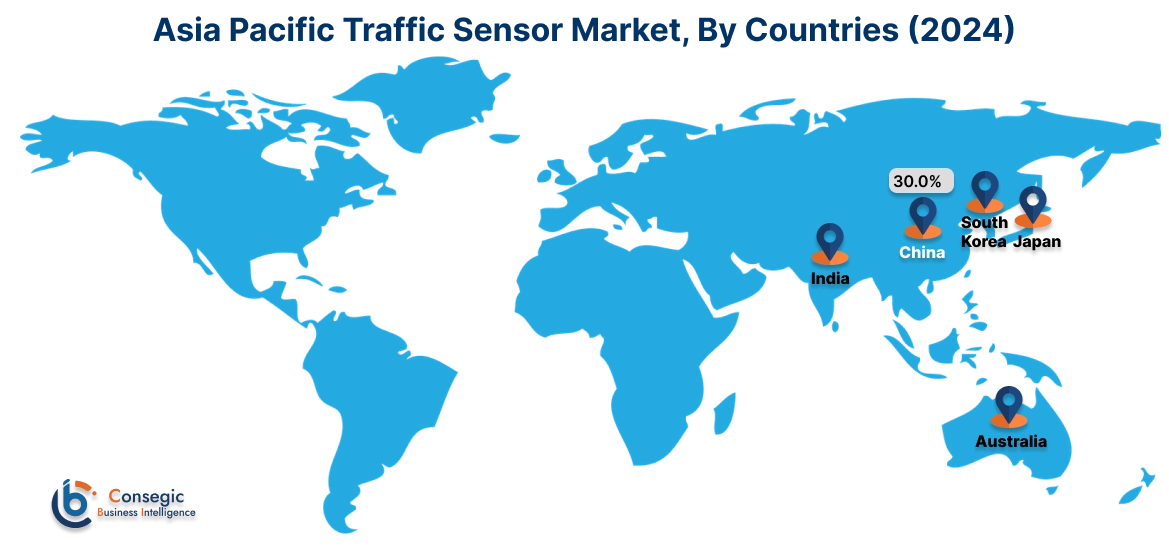
North America is estimated to reach over USD 509.01 Million by 2032 from a value of USD 280.55 Million in 2024 and is projected to grow by USD 297.47 Million in 2025. In North America, the growth of the traffic sensor industry is driven by the rising demand for smooth mobility across various cities to improve passenger experience. The rising trend for modern traffic solutions in modern city infrastructures is also driving industry growth. Hence, the investment growth in modern smart city projects is contributing to the traffic sensor market demand.
- For instance, in October 2023, International Road Dynamics Inc. partnered with the California Department of Transportation for e-screening (Ramp Electronic Screening) systems for tracking and screening vehicles.
The regional analysis depicts that the growing demand for advanced sensors to enhance the efficiency of public transportation networks is driving the traffic sensor market demand in Europe. Further, as per the market analysis, the primary factor driving the market growth in the Middle East and African region includes increasing investment in smart city projects for improving road infrastructure and network among others. The rising demand for advanced solutions for congestion management is accelerating the demand for intelligent transportation systems, which in turn is driving the market growth in the Latin America region.
Top Key Players and Market Share Insights:
The traffic sensor market is highly competitive with major players providing services to the national and international markets. Key players are adopting several strategies in research and development (R&D), product innovation, and end-user launches to hold a strong position in the global traffic sensor market. Key players in the traffic sensor industry include -
- Teledyne FLIR (US)
- TE Connectivity Ltd (Ireland)
- Efkon AG (Austria)
- Leddartech (Canada)
- International Road Dynamics Inc. (Canada)
- Siemens (Germany)
- Axis Communications AB (Sweden)
- Kapsch Trafficcom AG (Austria)
- Raytheon Company (US)
- Q-Free ASA (Norway)
Recent Industry Developments :
Product Launches:
- In May 2024, Bitsensing launched 24GHz TIMOS (Traffic Insight Monitoring Sensor), which is powered by the NVIDIA Jetson platform for real-time traffic monitoring.
Traffic Sensor Market Report Insights :
| Report Attributes | Report Details |
| Study Timeline | 2019-2032 |
| Market Size in 2032 | USD 1,443.56 Million |
| CAGR (2025-2032) | 8.6% |
| By Component |
|
| By Sensor |
|
| By Application |
|
| By Region |
|
| Key Players |
|
| North America | U.S. Canada Mexico |
| Europe | U.K. Germany France Spain Italy Russia Benelux Rest of Europe |
| APAC | China South Korea Japan India Australia ASEAN Rest of Asia-Pacific |
| Middle East and Africa | GCC Turkey South Africa Rest of MEA |
| LATAM | Brazil Argentina Chile Rest of LATAM |
| Report Coverage |
|
Key Questions Answered in the Report
How big is the traffic sensor market? +
The traffic sensor market was valued at USD 788.88 Million in 2024 and is projected to grow to USD 1,443.56 Million by 2032.
Which is the fastest-growing region in the traffic sensor market? +
Asia-Pacific is the region experiencing the most rapid growth in the traffic sensor market.
What specific segmentation details are covered in the Traffic Sensor report? +
The traffic sensor report includes specific segmentation details for component, sensor, application, and region.
Who are the major players in the traffic sensor market? +
The key participants in the traffic sensor market are Teledyne FLIR (US), TE Connectivity Ltd (Ireland), Siemens (Germany), Axis Communications AB (Sweden), Kapsch Trafficcom AG (Austria), Raytheon Company (US), Q-Free ASA (Norway), Efkon AG (Austria), Leddartech (Canada) and International Road Dynamics Inc. (Canada).
